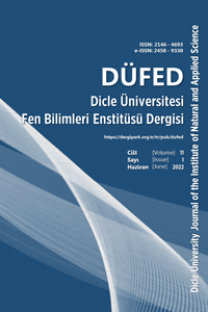Pamukta gossypium spp. in vitro koşullarında farklı hormon konsantrasyonlarının anter kültürü ile embriyo oluşumuna etkisi
Çalışmanın amacı, pamukta anter kültürü tekniğini kullanarak olgunlaşmamış taraklardan alınan anterlerin in vitro koşullarında farklı hormon konsantrasyonlarnın anter kültürü ile embiryo oluşumuna etkisinin incelenmesidir. Pamuk bitkisinin üç farklı genotipi, Aşkabat-100 Gossypium barbadense L. , Coker-312 ve Stoneville-468 Gossypium hirsutum L. ’den alınan taraklar kallus indüksüyonu için çalışılmıştır. Araştırmada farklı boylardaki olgunlaşmamış çiçek tomurcuklarından alınan pamuk anterleri 2, 3, 4 ve 5 mm kullanılmıştır. En yüksek oranda embriyogenik kallus, Aşkabat-100 genotipinde, 2 mm 97.00 , Stoneville-468 genotipinde 5 mm 72.63 , Coker-312 genotipinde 3 mm 55.80 büyüklüğe ulaşmış anterler ile başlatılan kültürlerden elde edilmiştir. Araştırma sonucunda, Aşkabat-100 çeşidi embriyoid kallus, embriyoid ve embriyo oluşumu için en uygun sonuçların alındığı gentip olarak saptanmıştır. Daha sonra embriyoya dönüşen embriyoid kalluslar için en iyi değerler, hormonsuz 90.73 , 0.1-0.5 mg/l kinetin ilaveli 76.00-61.60 ve 2.0 mg/l 2,4-D ilaveli 97.00 , ortamlarda ölçülmüştür. En yüksek embriyo ve sürgün oluşumu 66.47 0.5 mg/l kinetin içeren besi ortamında gerçekleşmiştir. Embriyonun globüler, kalp, torpedo ve kotiledon evreleri saptanmış, embriyoların olgunlaşmasıyla çoğaltılmış, çimlenme meydana gelmiş ve 0.5-10 cm uzunluklarında sürgün elde edilmiştir
The effect of dıfferent hormone concentratıons on anther culture and embryo formatıon ın vıtro condıtıons ın cotton gossypıum spp.
The aim of the study is taking the anthers obtained from immature squares to culture in appropriate medium by using the anther culture technique in cotton and ensuring that the shoots grow into plantlet from previously obtained embryos. Aşkabat-100 Gossypium barbadense L. , Coker-312 and Stoneville-468 Gossypium hirsutum L. were studied for callus induction. In the research, cotton anthers taken from immature flower buds of different lengths 2, 3, 4, 5 mm were used. In the initiated cultures; in different length anthers, in Aşkabat100 type, the maximum rate of embyroid callus obtained is at 2 mm 97.00 , in the Stoneville-468 type at 5 mm length 72.63 and in the Coker-312 anther the highest rate of embryoid callus formation obtained is at 3 mm anther length 55.80 . As a result of the research, Aşkabat-100 type produced the best results for embryoid callus, embryoid and embryo formation. For embryogenic calluses later turning into embryoids, the most suitable values are measured in non-hormone 90.73 0.1-0.5 mg/l kinetin supplemented 76.00-61.60 and 2.0 mg/l 2,4-D supplemented 97.00 medium. The highest embryo and shoot development were obtained in medium containing 66.47 0.5 mg/l kinetin. Embryo images for globular, heart, torpedo and kotiledon phases are obtained. After that, reproduction with maturing embryos and germination was observed and shoots were obtained 0.5-10 cm in length
Keywords:
Tissue Culture, Square, Anther, Kallus and Cotton,
___
[1] Bajaj, Y.P.S. and Gill, M.S., 1992. Micropropagation of Cotton (Gossypium spp.). Biotechnology in Agriculture and Forestry 19, High-Tech and Micropropagation III, Ed. ByBajaj, Y.P.S. 483-504. Springer Verlag Berlin Heidelberg New York.[2] Dunwell, J.M., 1986. Pollen. Ovule and embryo culture. astools in plant breeding. In: Withers LA. Alderson P.G. (eds). Plant tissue culture and its agricultural applications. Butter worths. London. pp 375– 404. Germana, M.A., 1997. Haploidy in Citrus. In: Jain, S.M., Sopory, S.K., Veilleux, R.E. (eds). In vitro haploid production in higher plants. vol 5. Kluwer. Dordrecht. 195–217
[3] Germana, M.A. 2006. Doubledhaploidproduction in fruitcrops. Plant Cell Tissue Organ 86: 131–146
[4] Germana, M.A., 2007. Haploidy. In: Khan I (ed) Citrus. Genetics, Breeding and Biotechnology. CABI. Wallingford. 167–196
[5] Germana, M.A., 2009. Haploid and doubled haploids in fruittrees. In: Touraev, A.,Forster, B., Jain, M. (eds). Advances in haploid production in higher plants. Springer. Heidelberg. 241– 263.
[6] Hu, H.,Yang, H.Y. (eds). 1986. Haploids in higher plants in vitro. China Academic Publishers/Springer, Beijing/Berlin.
[7] Raghavan, V., 1990. From microspore to embryo: faces of the angiosperm pollen grain. In: Nijkamp, H.J.J. van der Plas, L.H.,vanHartrigik, J. (eds). Progress in plant cellular and Molecularbiology. I.A.P.T.C. Kluwer. Dordrecht. 213–221.
[8] Reinert, J.,Bajaj, Y.P.S. 1977a. Anther culture: haploidproductionanditssignificance. 249-340
[9] Reinert, J.,Bajaj, Y.P.S. 1977b. Applied and fundamental spects of plant cell. Tissue and organ culture. Springer. Berlin Heidelberg New Yok. 341-464
[10] Sangwan-Norreel, B.S.,Sangwan, R.S., Pare, J., 1986. Haploı¨die et embryogene`seprovoque´e in vitro. Bull Society of BotanyFr 133. Actual Bot 4: 7–39.
[11] Sharma, A.K., Sharma, A. 1972. Chromosometechniques. Butter worths/University Park Press, London/ Baltimore. 575
[12] Testillano, P.S., Coronado, M.J., Seguı`-Simarro, JM., Domenech, J., Gonzalez-Melendi, P., Raska I., Risueno M.C., 2000. Defined nuclear changesac company there programming of the microsporeto embryogenesis. J StructBiol 129:223–232.
[13] Turaev, A.M. and Shamına, Z.B., 1985. Optimization of the Medium for Cotton Anther Culture. K.A. Timiryazev Institute of Plant Physiology. Academy of Sciences of the USSR. Moscow. Translated from Fiziologiya Rastenii.
[14] Türkoğlu, Ş.R., 2004. Pamukta (Gossypium hirsutum L.) in vitro rejenerasyon olanakları üzerinde araştırmalar. Çukurova Üniversitesi Fen Bilimleri Enstitüsü Doktora tezi. Adana
[15] Wenzel, G., Frei, U., Jahoor, A., Graner, A., Foroughghi-Wehr, B., 1995. Haploids—an integral part of applied and basic research. In: Terzi. M., et al (eds) Curren tissues in plant molecular and cellular biology. Kluwer. Dordrecht. 127–135.
- ISSN: 2146-4693
- Yayın Aralığı: Yılda 2 Sayı
- Başlangıç: 2012
- Yayıncı: Dicle Üniversitesi
